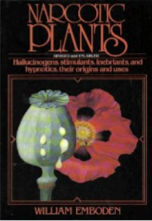Book Review






William Emboden’s Narcotic Plants provides an excellent presentation of the botany of psychoactive plants. It gives an overview of the historical and contemporaneous use of a vast variety of narcotic plants throughout the world. The original edition, printed in 1972, was momentous for its time because it was the first book of its kind to provide color illustrations and an appendix containing the chemical makeup of these plants. In 1979, the second edition of Narcotic Plants was written. This newer edition contains greater accuracy with regards to the chemical composition of plants, as well as greater historical context of the use of these plants.
Narcotic Plants was written for an audience with minimal background in the natural sciences. Definitions are provided as needed; even for basic terms such as “nartocits.” This book provides unbiased facts about different narcotic plants. The author simply describes these drugs in a scientific, “matter of fact” tone, and reserves judgment as to the recreational use of these drugs. This book is not intended as a guide to the recreational use of narcotics. Rather, it seeks to teach the reader the botany of narcotic plants and aims to dispel common misconceptions about these drugs.
The book begins with an interesting account of the history of narcotics in a section titled, “The Origins of Narcotic Plant Use.” While the historical context of most of the plants mentioned throughout this book and taken into account, this section serves as an overview of the roots of narcotic use- recreational and medicinal. It also provides historical context to the ideology of narcotic use in different regions of the world. For example, the use the narcotic plant Cannabis is described by many cultures as a euphoriant and extremely important for religious purposes, it has been described as a “death-dealing weed” in America. Interesting contradictions such as these are examined though out the book.
Narcotic Plants is divided into 5 chapters, separated by different classifications of narcotics: 1) Hypnotica, the sedatives and tranquilizers; 2) Tobacco, the enigmatic narcotic; 3) Hallucinogens; 4) Stimulants; 5) Inebriants. This set up helps make this book great for easy research and as a quick reference source. The chapters are all similar in structure and style; the chemistries of different plants are discussed, and historical context is given for the different drugs associated with those plants. The effects of these drugs on the human body are also examined, in the context of why they are construed the way they are in different societies.
The well-designed appendix also provides an easy resource tool. Appendix I (A Proposed Structuring of Some Known Mind-Altering Plant Chemicals) outlines the psychopharmacology of narcotic plants in an easy to navigate list sorted by side effects. Appendix II (A Summation of the Botany, Geography, Psychopharmacology and Chemistry of Narcotic Plants) provides a synopsis of the different plants aforementioned in the text. Included in Appendix II are the Genus, species, family, habitat, botanical descriptin, primary narcotic effect, and local/common names of every narcotic plant in the book.
This is a great book for anyone looking to delve into the fascinating study of botanical narcotics. Whether reading for pleasure or conducting research, this book is a great choice if you are interested in narcotic stimulants. Little prior knowledge is necessary to read and appreciate this book. The color pictures serve as a great reference tool, and the appendices also provide valuable information. William Emboden’s easy to read style and clear scientific verbiage makes this book a great read for anybody interested in this topic.
“I do not readily believe that any man, having once tasted the divine luxuries of opium will afterward descend to the gross and mortal enjoyments of alcohol.”
- Thomas de Quincey
Monday, January 30, 2012


Narcotic Plants






